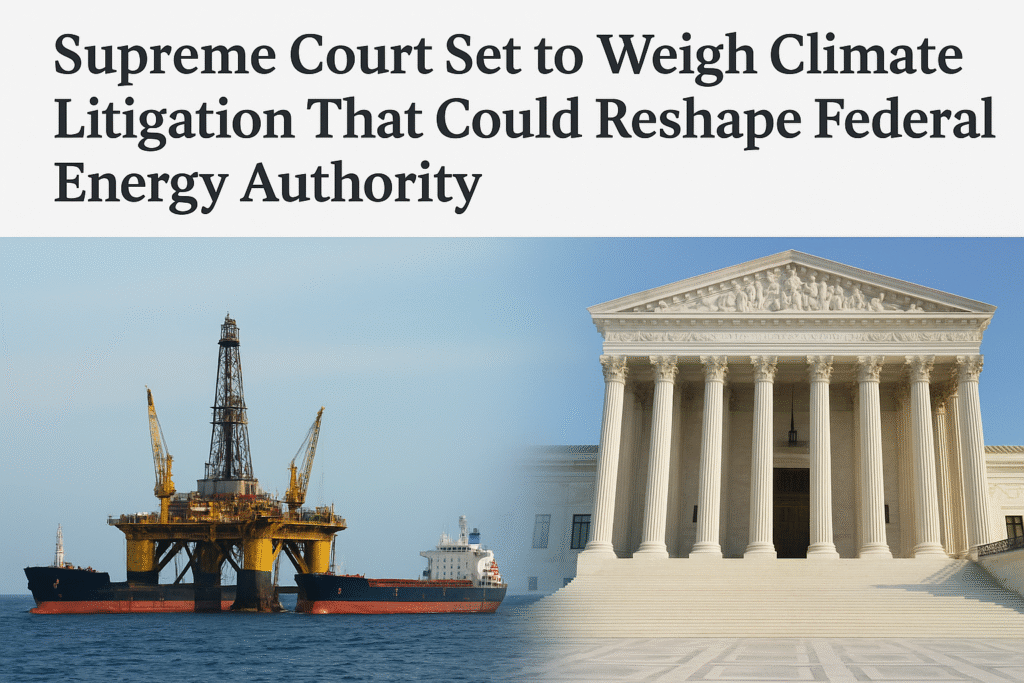
As climate change lawsuits against oil and gas companies advance through state courts across the United States, the Supreme Court is preparing to consider cases that may redefine the boundary between state-led litigation and federal authority over national energy policy. The outcomes could have long-lasting consequences for both environmental regulation and the future of the American energy industry.
The Rise of Climate Litigation
Over the past decade, a wave of lawsuits has been filed by states, counties, and municipalities against major fossil fuel producers. These suits often seek compensation for damages allegedly caused by climate change, such as coastal flooding, sea-level rise, and severe weather events. Plaintiffs argue that energy companies knowingly contributed to global warming while downplaying or concealing the risks of fossil fuel consumption.
The legal strategies have drawn comparisons to earlier public health litigation. Just as tobacco companies were sued for concealing the risks of smoking and pharmaceutical companies faced liability in opioid cases, plaintiffs in climate lawsuits claim oil and gas corporations misled the public about the consequences of greenhouse gas emissions.
Boulder County v. Suncor Energy
One of the most closely watched cases is Boulder County v. Suncor Energy, currently moving through the Colorado state court system. Boulder County, joined by other municipalities, alleges that major oil companies should be held financially responsible for climate-related damages, ranging from increased wildfire risks to infrastructure costs related to extreme weather.
The Colorado Supreme Court allowed the case to remain in state court earlier this year, rejecting efforts by energy companies to move it to the federal system. The companies argue that such lawsuits are inherently federal in nature, since climate change involves cross-border and even global emissions. They warn that allowing individual states to impose liability could create a patchwork of conflicting policies, undermining federal authority.
The U.S. Supreme Court is expected to decide soon whether it will take up the case, a decision that could determine the future scope of climate litigation nationwide.
Other Key Cases in State Courts
Similar lawsuits are advancing in Hawaii, Rhode Island, Maryland, South Carolina, and other states. Each case tests whether local governments can seek damages under state tort law for harms tied to climate change.
In Hawaii, for instance, a lawsuit seeking damages for rising sea levels has been allowed to move forward. The Hawaii Supreme Court emphasized local cultural and environmental values in its reasoning, framing the litigation as consistent with the state’s long-standing environmental protections.
In Rhode Island, a state judge drew international comparisons, likening the state’s vulnerability to climate-related disasters to that of developing nations. Critics argue such reasoning risks inflating rhetoric at the expense of legal clarity.
Not all state courts have been receptive, however. Judges in Pennsylvania, New York, Delaware, New Jersey, and South Carolina have dismissed similar claims, though appeals are pending.
Louisiana’s Wartime Oil Case
Another case attracting national attention stems from Louisiana, where plaintiffs successfully argued that decades-old oil extraction practices contributed to coastal erosion. A state court ordered Chevron to pay $750 million in damages, with interest potentially raising the judgment to more than $1 billion.
The case is unusual because the disputed oil production occurred during World War II under federal contracts to supply aviation fuel. The companies maintain that their actions were carried out in cooperation with the federal government, making state-level liability inappropriate.
The Fifth Circuit Court of Appeals declined to move the case into federal jurisdiction, though one dissenting judge argued that the connection to wartime production clearly implicated federal interests. The Supreme Court has agreed to review the decision this term.
Federal vs. State Authority
At the heart of these disputes lies a fundamental question: should state and local governments have the power to impose liability on corporations for global climate impacts, or should such decisions rest with federal policymakers?
Supporters of the lawsuits argue that local communities are on the front lines of climate change, facing rising costs for disaster response, infrastructure resilience, and public health. They contend that fossil fuel companies profited for decades while externalizing the costs of their products onto society.
Opponents counter that climate change is a global issue requiring national and international solutions, not piecemeal litigation. They warn that state-level lawsuits could disrupt energy markets, discourage future cooperation between businesses and the federal government, and drive up energy costs.
Past Legal Precedents
Federal courts have previously signaled skepticism toward state-based climate claims. In 2021, the Second Circuit Court of Appeals dismissed New York City’s lawsuit against Chevron, ruling that global emissions and climate-related damages cannot be addressed through state nuisance laws. The court concluded that such claims fall squarely within the domain of federal law and international diplomacy.
That precedent, along with several other dismissals, may weigh heavily in the Supreme Court’s consideration of upcoming cases.
Broader Implications
The stakes extend beyond the courtroom. If the Supreme Court rules that climate lawsuits belong in state courts, energy companies could face an expanding array of claims across multiple jurisdictions. Even unsuccessful suits impose significant litigation costs, which companies argue could deter investment in domestic energy production.
If, on the other hand, the Court reaffirms federal primacy, many pending cases may be dismissed or redirected, effectively limiting the role of state courts in shaping climate policy.
Either outcome could influence how the United States confronts climate change — whether through a coordinated federal approach, or through a mosaic of state-led initiatives and local legal actions.
Looking Ahead
The Supreme Court is expected to hear arguments on the Louisiana case this term and could soon decide whether to take up the Colorado litigation. Together, these rulings could set a national precedent for how climate accountability claims are handled in the future.
As the legal battles continue, communities, corporations, and policymakers await clarity on a question that sits at the intersection of law, science, and public policy: who should bear responsibility for the costs of climate change?